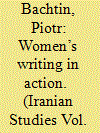| Srl | Item |
| 1 |
ID:
142767


|
|
|
|
|
| Summary/Abstract |
The aim of this paper is to describe and analyse the royal harem and its functions during the reign of Naser al-Din Shah Qajar (r. 1848–96), on the basis of two independent Persian-language sources written by noble Iranian women at the turn of nineteenth and twentieth centuries: Naser al-Din's daughter, Taj al-Saltana (1884–1936), who in her famous memoirs vividly rendered her early years spent on her imperial father's court, and ‘Lady from Kerman’ (whose identity remains, for the moment, unclear), who authored a latterly published travelogue of pilgrimage to Mecca and the holy Shi'a places in contemporary Iraq held by her in the early 1890s. The second part of the latter account is entirely dedicated to the sojourn in Tehran, where, upon coming back from the sacred journey, the woman was a frequent guest at the royal harem. Both accounts are unique as they are the only known first-hand sources penned by the female insiders of the harem in nineteenth-century Iran. Furthermore, both authors, who actually met each other, describe the same figures and events – which provide an opportunity to compare their relations and augment our knowledge about Iran in the late Naseri period.
|
|
|
|
|
|
|
|
|
|
|
|
|
|
|
|
| 2 |
ID:
177797


|
|
|
|
|
| Summary/Abstract |
This paper examines the textual and performative functions of early women’s writings on the example of three accounts of the pilgrimage to Mecca written during the Qajar era by Mehrmāh Khānom ʿEsmat al-Saltaneh (1880–81), the anonymous Hājiyeh Khānom ʿAlaviyeh Kermāni (1892–94), and Sakineh Soltān Vaqār al-Dowleh Esfahāni Kuchak (1899–1901). It ponders on the relationships between the female writers and textuality, their readers and, finally, the diary personas they created. It claims that their writings emerged in the process of negotiating the then existing, masculine models of textuality and authorial authority. By rejecting the monologic authoritativeness of literature and textuality, the women diarists transformed their texts into a space for dialogue—including dialogue with themselves.
|
|
|
|
|
|
|
|
|
|
|
|
|
|
|
|